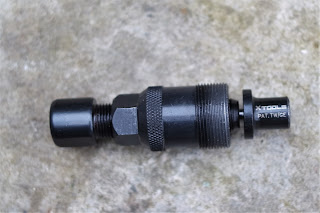A week down the line and I’m getting better acquainted with the CamPark V40 Action Camera and find it generally intuitive. Forgoing the waterproof housing has addressed the issues with microphone buzz. Video capture is also reasonably good, especially when mounted directly to an aftermarket mount.
This Minoura VC100 S has been a consistent feature of Ursula’s bars for 8 years. The shock-absorbing cork platform expired last year, substituted with a rubber shim doing something close to nothing in my spares box.
This overcomes any minor blurring that could strike along washboard tarmac, even with the in-camera stabilisation engaged. Action cameras have relatively small sensors, hence while the image quality is favourable in bright conditions (sun and snow for example) low light performance is less consistent.
I’ve switched the gasket-sealed weatherproof housing to my fixed gear winter/trainer. Not that I’m pensioning off the Geonaute G-Eye 2 Escape. Though quite elderly and with fewer bells and whistles than we’d expect from a more contemporary model, it’s still reliable and delivering decent footage. I suspect it will become bin fodder once the integrated battery expires, mind.
Some bar tidying followed, since time allowed. The K-lite Bike packer Pro V2’s switch now nestles beside the lamp and the ORP Smart HornTESTED: ORP SMART HORN (sevendaycyclist.com) in its place. Neater and presented the opportunity to snug down some otherwise easily overlooked fasteners.
Another batch of DIY corrosion inhibitor has also been brewed. I’d usually make more but this was plentiful for topping up the KA and Micra’s protection. Applying during any damp period will simply seal the moisture IN, which defeats the object. This formula is made using candlewax, solvent and whatever cheap as chips motor oil I have laying around.
While tending to Ursula’s mudguard hardware, I noticed the Lezyne pump had been “wood peckering” the tubby tourer’s down tube, marking the cream powder coat. After The Gritters Went Home | Seven Day Cyclist, so, I polished the blemish out, placed a sticker and a piece of Zefal Skin armor ZEFAL SKIN ARMOR ROLL | cycling-not-racing (sevendaycyclist.com) atop for peace of mind/additional insurance. While Ursula’s chain might be sporting a slightly scuzzy beard, the SKS Lube Your Chain TESTED: SKS LUBE YOUR CHAIN (sevendaycyclist.com) is a waxy formula that seems to lock contaminant in the outer layer, so it can’t become a ruthlessly effective grinding paste.
A little goes a very long way, stays put and friction is also comparatively low. If forecasts are accurate, a spell of higher pressure is to hit the UK in the next week, which might present the opportunity for lighter lubes and some serious miles on the Teenage Dream. Meantime, I’m allowing the Univega to become uncharacteristically filthy in preparation for this bike wash.
Some people will argue (and I can understand their angle) that these are unnecessary.
Car wash formulas are cheap as chips, will strip the grot, and leave a protectant barrier behind. I freely admit to being a fan, especially during winter when time is dictated by temperature and available daylight. My preference leans towards concentrates, which I can brew to taste i.e. a degreaser for a deep component clean, a winter weight grot softener, and one for lighter, generic blow-overs.
Much the same principle when it comes to lubes, maintenance sprays, and freeing agents. A very thin spray, like GT85GT85 ALL PURPOSE LUBRICANT (sevendaycyclist.com) is great for displacing moisture post wash freeing sticky cables and will even ease a reluctant seatpost. However, immobile, or semi seized stuff requires a penetrant spray. In a pinch, strong solvent-based degreasers/disc brake cleaners can also save the day.
Technique also plays a part on the efficiency front. Taking stuck seatposts as an example, wrapping an old bubble wrap envelope (cut down) into a cone shape and secure it around the seat tube with a zip tie (having removed the seat bolt).
Deliver a quick shot directly at the post and tap the saddle with a rubber “engineer’s” mallet. Now deliver subsequent blasts into the envelope, in a circular motion, this will see it travel inside the post steadily. Give the saddle regular firm taps, every few minutes to encourage penetration, break the seal of corrosion and ultimately, free the post. Similar technique for old-fashioned quill stems, too.
I also keep a stockier maintenance spray for protecting fasteners from corrosion, longer-term lubrication to brake/gear cables, masking electroplated frame/fork ends, keeping locking/mechanisms mobile. Horses for courses, is my point. Talking of which, those seeking a small-wheeled magnesium e-folder might be interested in this MIRider MIRIDER 2021 | cycling-not-racing (sevendaycyclist.com)

























